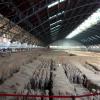China is often thought of--almost known for--being a homogenous society, and at first glance it's easy to see why. However, what many people do not know is that China's makeup consists of 56 different ethnic groups. The majority of Chinese people are Han--91.25% to be exact. The other 55 groups make up the remaining 8.75%. One of these groups are the Hui people who I stayed with during our trip to Ningxia. The name "Hui" orginates from the Qing dynasty. Native Chinese people began calling the Middle Eastern traders who settled down in China after traveling on the silk road "Hui Hui". The character for "Hui" in Chinese means to return and since these settlers were mostly Muslim, they wanted to make the Hajj back to Mecca. As a result, they became known as "people who want to return home". Over time these settlers married with native Chinese and many converted to Islam. These people are now known as "Hui Zu" and have a heavily concetrated population in Ningxia autonomous region of China. I had heard of this ethnic group the first week I arrived in Beijing (our program director is Hui and there are several Hui-owned restaraunts near campus), but traveling to Ningxia gave me a chance to learn more about the history of the Hui people and what sets them apart from the Han.
One of the biggest differences is that most Hui people practice Islam. They are not the only Muslims in China, but they do account for a large portion of the Chinese Muslim population. I was shocked by how heavily this cultural background shaped the landscapes of the cities we visited. When we visited Tongxin, which has about a 50% Hui population, we hardly only one bar and hardly any shops that sold alochol. Even in the cities with a lower population of Hui people--Yinchuan and Zhongwei, 30% and 10% respectively--the types of clothing, food and other items sold in stores was drastically different than what I have grown used to seeing in Beijing.
The day I learned the most about the Hui people was when we stayed in an all-Hui village in the countryside of Tongxin. We spent most of the day walking around the village and playing with some of the Hui children. For most of them, my classmates and I were the first foreginers they had seen. Although many of them were shy at first, a few warmed up quickly. Two girls started playing with my hair and asking me questions about America. To my surprise, most of the questions they had were about food. "Do Americans eat pigs?" they asked. That one made sense to me; our tour guide had told us all that they didn't eat pork here, but then they followed with more, "Do Americans eat bugs? Dogs? Horses?". I answered as honestly as I could.
Later that evening, their questions made a lot more sense. During a Q&A session with the religious leader of the town we learned more about the rules of Islam regarding food and keeping Halal. According to this man, Muslims only eat animals that have two "toes" on their feet (with the exception of pigs of course). For example, they'll eat cows, but not horses, sheep, but not dogs. They also only eat birds that cannot fly and do not eat other animals, so they'll eat chickens, but not eagles. This system of rules seemed complicated to me, until I started comparing it to some of my friend's diets back home--vegetarians, pescetarians, vegans, paleo, etc. My own dietary restrictions stem from allergies and celiac disease, but this experience reminded me that there is always more than one reason to eat or not eat certain foods.
Aside from food and minority ethnic groups, this trip also showed me another side of China's diversity--its geography. Being in a city like Beijing that the same four seasons as my own hometown made me forget how large of a country China actually is. When any country is as big as China, its bound to cover a lot of ground (literally) when it comes to topography. Ningxia itself has a much drier climate than Bejing, but within this one province we were able to see flat farm land, mountain ranges and sandy deserts. What shocked me even more is that these places could all be found within a few hours' drive of each other.
Though I don't have any more large-scale travel plans for the remainder of my time in China, this trip really opened my eyes to the different ways China's diversity is manifested. Like America and every other country, the general population can always be broken down into smaller groups distinguished by any number of characteristics. Though this diversity may not always be apparant at a first glance, it only takes a little exploration to find it wherever you are.

Kelly Cunningham
<p>My name is Kelly Cunningham and I am a Chinese Studies and English major at DePaul University. I love everything about languages-reading them, writing with them, speaking them, etc. I'm studying abroad to improve my Chinese and learn more about the culture.</p>







